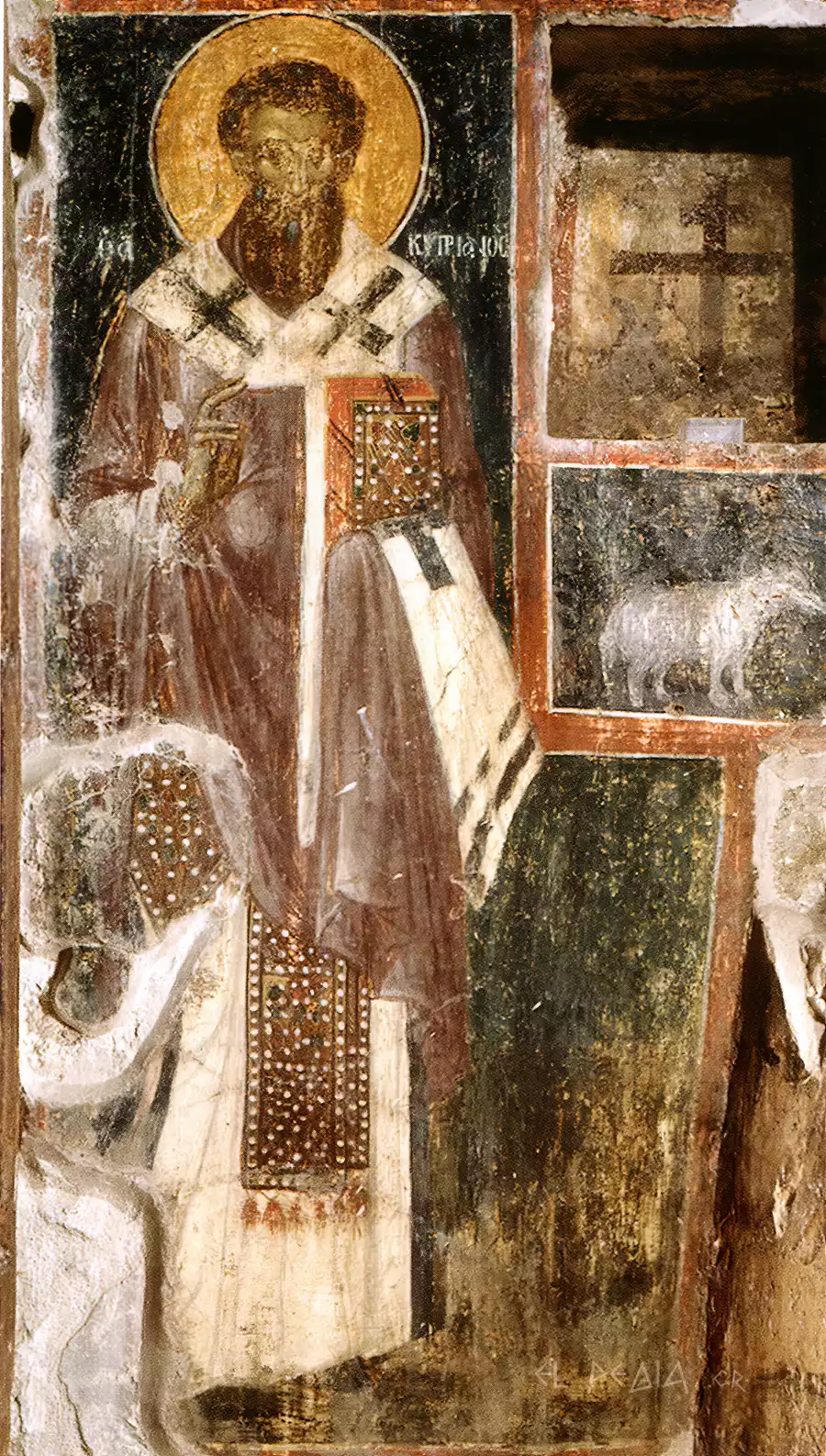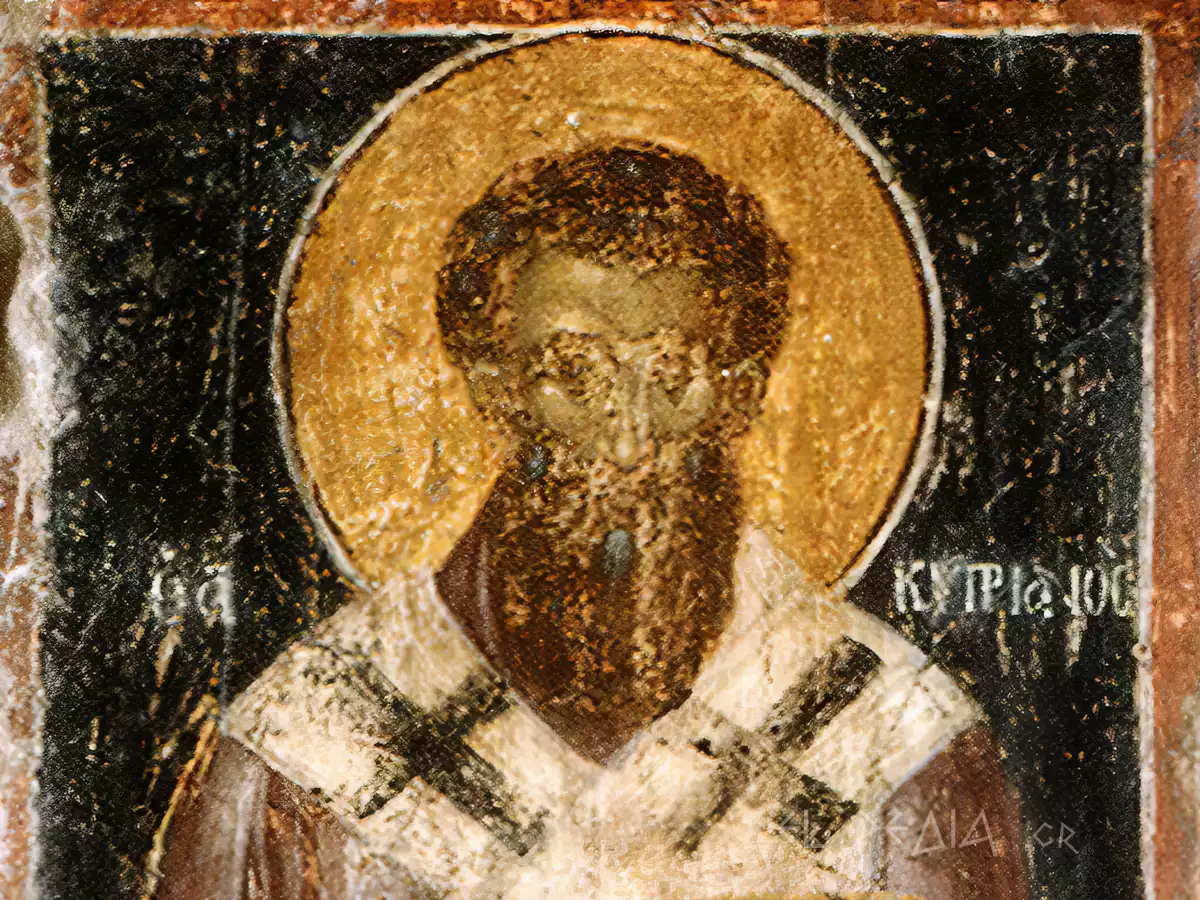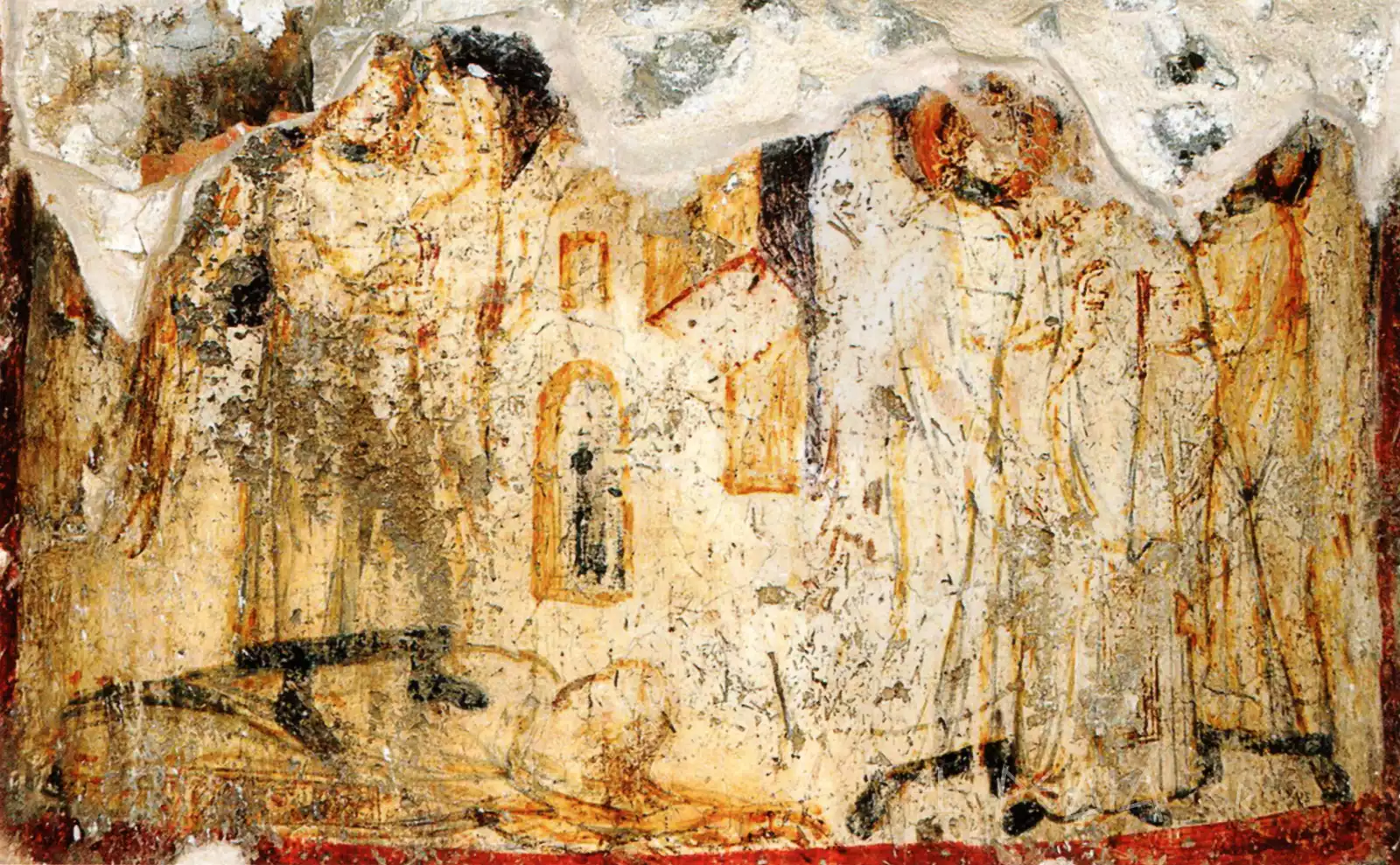
Title: Fresco of Saint Cyprian
Artist: Unknown
Type: Fresco
Date: Early 15th century
Dimensions: Unknown
Materials: Fresco on plaster
Location: Holy Monastery of Valsamonero, Church of Panagia Odigitria, Crete
The fresco of Saint Cyprian is an excellent example of late Byzantine art from the early 15th century, adorning the walls of the Holy Monastery of Valsamonero in Crete. The work captures with unique mastery the artistic tradition of the Cretan School, combining Byzantine and Western elements. The mural is part of the broader iconographic program of the church of Panagia Odigitria, dating to the period of Venetian rule. The unknown artist has depicted Saint Cyprian in episcopal attire, holding the Gospel, reflecting his hierarchical status. The fresco is distinguished by its exceptional technical execution, detailed rendering of the clothing elements, and the intense spirituality exuded by the figure of the Saint. The art of mural painting reflects the complex cultural identity of Crete during the period of Venetian rule, where Byzantine tradition coexisted and interacted with Western influences.

Stylistic Characteristics and Symbolisms
The fresco of Saint Cyprian at the Valsamonero Monastery is an outstanding example of post-Byzantine art of Crete. The technical execution of the mural is characterized by particular finesse in the rendering of details and exceptional skill in the use of colors. The unknown artist has managed to impressively render the folds of the episcopal vestments, creating a sense of movement and volume that gives life to the figure.
The composition of the mural follows the traditional Byzantine art in the depiction of hierarchs, with the Saint presented frontally in a stance of supplication, while simultaneously incorporating elements that reflect the artistic renewal of the period (Kitzinger). The color palette used is rich, with dominant earthy tones and golden details that emphasize the divine nature of the depicted figure, while the gradation of tones and fine shading create a sense of depth and spirituality that characterizes the artistic tradition of the era. Of particular interest is the depiction of the Saint’s face, where the artist has succeeded in combining the austerity of the priestly expression with an inner calm that reflects his spiritual essence, while the careful treatment of facial features and the detailed rendering of the beard and hair reveal the creator’s high technical proficiency and dedication to the tradition of the Cretan School, which uniquely combined Byzantine and Western elements during the period of Venetian rule.
The iconographic composition is enriched by the presence of inscriptions in Greek script that frame the figure of the Saint, following the established practice of Byzantine art for identifying the depicted figures. The way in which the artist has incorporated these epigraphic elements into the composition reveals a deep understanding of traditional iconography, while also demonstrating an exceptional ability in organizing the visual space. The preservation of the mural in good condition allows for a detailed study of the artist’s technique and the materials used, providing valuable information about the artistic practices of the era in Crete during the period of Venetian rule.
Historical and Artistic Context
The katholikon of the Valsamonero Monastery, with the exceptional mural of Saint Cyprian, reflects the cultural diversity of Crete during the period of Venetian rule. The monastery, located on the southern slopes of Mount Psiloritis, still maintains its katholikon as a witness to the artistic flourishing of the 15th century. The architectural structure of the church, with its three aisles dedicated to Panagia Odigitria, Saint John the Baptist, and Saint Phanourios, reveals the gradual expansion and evolution of the monument.
The artistic influences that shaped the iconographic program of the church reflect the complex cultural identity of medieval Crete, where Byzantine tradition meets Western artistic trends (Bayet). The decoration of the church was carried out in different phases, with the northern aisle of Panagia dating to the 14th century, while the murals of the southern aisle, including the depiction of Saint Cyprian, were executed between 1407 and 1428.
The artistic production of the era is characterized by an exceptional synthesis of traditional and modern elements, as Cretan artists, working in an environment where Orthodox and Catholic traditions coexisted, developed a unique artistic dialogue that incorporated elements from both cultural traditions, thus creating a unique artistic idiom that characterized the Cretan School of iconography. The transverse aisle of Saint Phanourios, added in 1426 and frescoed in 1431 by the Cretan painter Konstantinos Rikos, is a characteristic example of the artistic evolution of the monument. The presence of Saint Phanourios, honored as a local saint on August 27, underscores the significance of the monument for the local religious tradition.
The restoration of the monument after 1947 by Nikolaos Platon contributed decisively to the preservation of this important example of post-Byzantine art. Today, the Valsamonero Monastery, located 53 kilometers from Heraklion, continues to be a living monument of the artistic and spiritual tradition of medieval Crete.

Analysis of the Donor Depiction
The donor depiction of the Valsamonero Monastery presents exceptional interest both artistically and historically. The composition, dating to the early 15th century, unfolds on a horizontal plane with a characteristic hierarchical arrangement of the figures. Despite extensive wear, the silhouettes of the figures are clearly discernible, rendered with a monumental character.
The artist has used a limited color palette, with dominant ochres and earthy shades, creating an atmosphere of spirituality and austere grandeur. The figures of the donors and monks are arranged with a rhythmic regularity reminiscent of Byzantine liturgical processions. The way depth is achieved through the overlapping arrangement of the figures is impressive. The technical execution of the mural reveals an artist with a deep knowledge of traditional iconography and exceptional skill in rendering details. The folds of the garments fall naturally, while the posture of the figures, although hierarchical, maintains an internal vitality. Noteworthy is the subtle gradation of tones on the faces, which despite the wear, reveals the artist’s effort to render individual characteristics.
The architectural structure of the background, with simplified buildings and decorative elements, creates a symbolic space that underscores the sacred character of the depiction. The geometric patterns and decorative details reveal influences from both Byzantine tradition and Western art of the time. The depiction, despite the wear of time, remains a valuable testament to the artistic production of Crete during the period of Venetian rule. It is a characteristic example of the synthesis of Eastern and Western elements that characterizes the art of the island during the 15th century.
Fresco Art in Valsamonero
The fresco of Saint Cyprian at the Valsamonero Monastery is a representative example of the artistic production of Crete during the period of Venetian rule. This composition highlights the unique coexistence of Byzantine tradition with Western influences, creating an exceptional example of the Cretan School. The technical perfection, detailed processing, and spiritual dimension of the work testify to the high artistic education of the creators of the era.
The preservation of the monument and its continuous study offer valuable information about the artistic production of medieval Crete, while also highlighting the importance of protecting and promoting our cultural heritage. The work remains a living witness to the cultural osmosis that characterized Crete in the 15th century, offering valuable insights into the evolution of art on the island.
elpedia.gr
Bibliography
Bayet, C. Byzantine Art. Google Books, 2023.
Eastmond, A. “The Limits of Byzantine Art.” In A Companion to Byzantium, edited by Liz James, 313-322. Chichester: Wiley-Blackwell, 2010.
Evans, HC. and Wixom, WD. The Glory of Byzantium: Art and Culture of the Middle Byzantine Era, AD 843-1261. New York: Metropolitan Museum of Art, 1997.
Kitzinger, E. “The Hellenistic Heritage in Byzantine Art.” Dumbarton Oaks Papers 17 (1963): 95-115.

